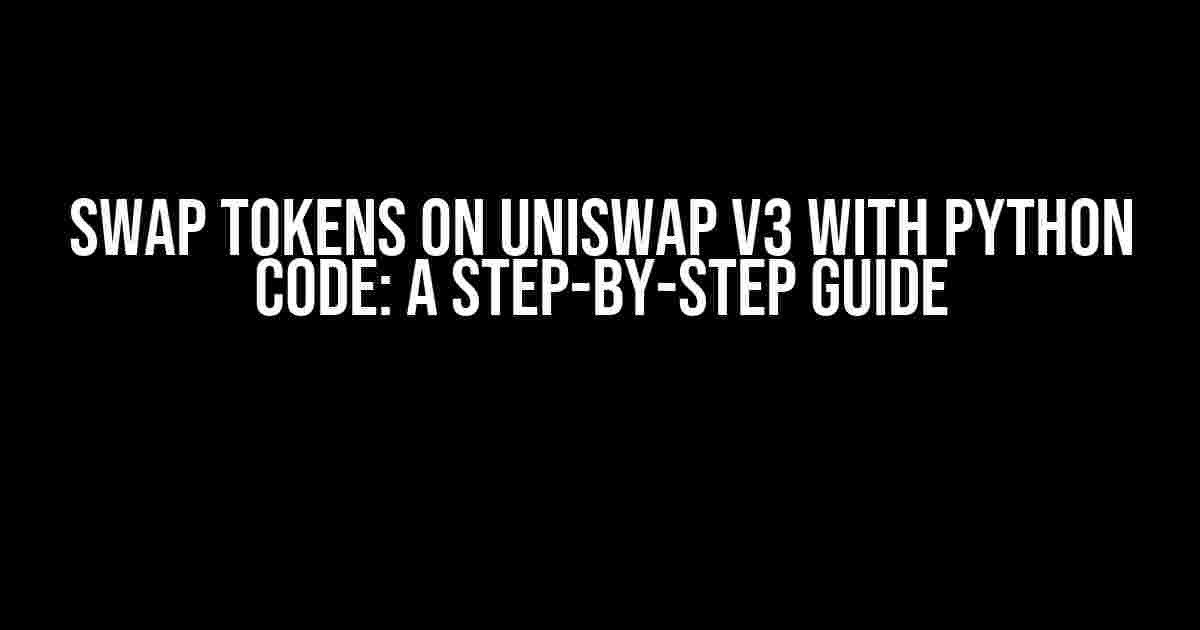Are you tired of manually swapping tokens on Uniswap v3? Do you want to automate the process with Python code? Look no further! In this article, we’ll take you through a step-by-step guide on how to swap tokens on Uniswap v3 using Python code. We’ll also troubleshoot a common error that may occur during the process: “insufficient funds for gas * price + value”. So, buckle up and let’s dive in!
What is Uniswap v3?
Uniswap v3 is a decentralized exchange (DEX) built on the Ethereum blockchain. It allows users to swap ERC-20 tokens in a trustless and permissionless manner. Uniswap v3 is an upgrade to the previous versions, offering improved liquidity, better pricing, and enhanced security.
What is Python Code?
Python is a popular programming language used for various purposes, including web development, data analysis, and automation. In this article, we’ll use Python to interact with the Uniswap v3 API and automate token swaps.
Why Swap Tokens on Uniswap v3 with Python Code?
Swapping tokens on Uniswap v3 with Python code offers several benefits, including:
- Faster execution: Python code can execute trades faster than manual swaps, reducing the risk of slippage and price fluctuations.
- Automation: Python code can be set up to automate token swaps at desired intervals, making it ideal for high-frequency trading and arbitrage strategies.
- Customization: Python code allows for customization of trading strategies, risk management, and position sizing.
Prerequisites
Before we dive into the Python code, make sure you have the following prerequisites in place:
- Ethereum wallet with sufficient funds (ETH)
- Uniswap v3 API key
- Python installed on your computer (version 3.8 or higher)
- Web3.py library installed (via pip install web3)
Python Code for Swapping Tokens on Uniswap v3
Here’s the Python code to swap tokens on Uniswap v3:
import web3
from web3 import Web3
# Set up your Ethereum wallet and Uniswap v3 API key
wallet_address = "0xYourWalletAddress"
api_key = "YourUniswapV3APIKey"
# Set up the Web3 provider
w3 = Web3(Web3.HTTPProvider("https://mainnet.infura.io/v3/" + api_key))
# Set up the token addresses and amounts
token_in = "0x6B175474E89094C44Da98B954EedeAC495271d0F" # DAI
token_out = "0xA0b86991c6218b36c1d19D4a2e9Eb0cE3606eB48" # USDC
amount_in = 100 # 100 DAI
# Get the Uniswap v3 router address
router_address = "0xE592427A0AEbE4C2574e4360291e7F961c246Da8"
# Approve the Uniswap v3 router to spend your tokens
approval_tx = w3.eth.contract(address=token_in, abi=[{"constant": True, "inputs": [], "name": "decimals", "outputs": [{"name": "", "type": "uint8"}], "payable": False, "stateMutability": "view", "type": "function"}]).functions.approve(router_address, amount_in * (10 ** 18)).transact({"from": wallet_address, "gas": 200000, "gasPrice": w3.eth.gas_price})
# Wait for the approval transaction to be mined
w3.eth.wait_for_transaction_receipt(approval_tx.tx_hash)
# Create the Uniswap v3 swap transaction
swap_tx = w3.eth.contract(address=router_address, abi=[{"constant": False, "inputs": [{"name": "tokenIn", "type": "address"}, {"name": "tokenOut", "type": "address"}, {"name": "amountIn", "type": "uint256"}], "name": "swap", "outputs": [{"name": "", "type": "uint256"}], "payable": False, "stateMutability": "nonpayable", "type": "function"}]).functions.swap(token_in, token_out, amount_in * (10 ** 18)).transact({"from": wallet_address, "gas": 200000, "gasPrice": w3.eth.gas_price})
# Wait for the swap transaction to be mined
w3.eth.wait_for_transaction_receipt(swap_tx.tx_hash)
print("Swap successful!")
Error: Insufficient Funds for Gas * Price + Value
When running the above Python code, you might encounter an error: “insufficient funds for gas * price + value”. This error occurs when your Ethereum wallet does not have sufficient funds to cover the gas costs of the transaction.
Solution 1: Increase Gas Limit
One solution is to increase the gas limit of the transaction. You can do this by adjusting the “gas” parameter in the `transact` function. For example:
approval_tx = w3.eth.contract(address=token_in, abi=[{"constant": True, "inputs": [], "name": "decimals", "outputs": [{"name": "", "type": "uint8"}], "payable": False, "stateMutability": "view", "type": "function"}]).functions.approve(router_address, amount_in * (10 ** 18)).transact({"from": wallet_address, "gas": 400000, "gasPrice": w3.eth.gas_price})
Solution 2: Decrease Gas Price
Another solution is to decrease the gas price of the transaction. You can do this by adjusting the “gasPrice” parameter in the `transact` function. For example:
approval_tx = w3.eth.contract(address=token_in, abi=[{"constant": True, "inputs": [], "name": "decimals", "outputs": [{"name": "", "type": "uint8"}], "payable": False, "stateMutability": "view", "type": "function"}]).functions.approve(router_address, amount_in * (10 ** 18)).transact({"from": wallet_address, "gas": 200000, "gasPrice": w3.eth.gas_price * 0.5})
Solution 3: Top Up Your Ethereum Wallet
The most straightforward solution is to top up your Ethereum wallet with more ETH. Make sure you have sufficient funds to cover the gas costs of the transaction.
Conclusion
In this article, we’ve demonstrated how to swap tokens on Uniswap v3 using Python code. We’ve also troubleshooted a common error that may occur during the process: “insufficient funds for gas * price + value”. By following the solutions outlined above, you should be able to resolve the error and successfully swap tokens on Uniswap v3.
Remember to always be cautious when working with cryptocurrency and automation. Make sure to test your code in a simulated environment before executing it on the mainnet.
FAQs
| Question | Answer |
|---|---|
| What is the purpose of the Uniswap v3 API key? | The Uniswap v3 API key is used to authenticate your API requests and access the Uniswap v3 protocol. |
| Can I use this Python code for other decentralized exchanges? | No, this Python code is specific to Uniswap v3. You’ll need to modify the code to work with other decentralized exchanges. |
| How do I troubleshoot other errors that may occur during the process? | You can troubleshoot other errors by checking the Ethereum transaction logs, Uniswap v3 API documentation, and Web3.py library documentation. |
Additional Resources
For further learning and exploration, we recommend the following resources:
- Uniswap v3 API documentation: https://docs.uniswap.org/
- Web3.py library documentation: https://web3py.readthedocs.io/en/stable/
- Ethereum developer documentation: https://ethereum.org/en/developers/
We hope this article has been informative and helpful. Happy coding and
Frequently Asked Question
Get ready to dive into the world of Uniswap v3 and Python coding! Here are some frequently asked questions and answers to help you overcome common hurdles when swapping tokens on Uniswap v3 using Python code.
Why do I get an “insufficient funds for gas * price + value” error when swapping tokens on Uniswap v3 using Python?
This error occurs when your account doesn’t have enough Ethereum (ETH) to cover the gas fees required for the transaction. Make sure you have sufficient ETH in your wallet to process the swap. You can also adjust the gas price and limit to reduce the gas fee requirements.
How do I set the gas price and limit in my Python code to avoid the “insufficient funds” error?
You can set the gas price and limit using the `gas_price` and `gas` parameters in your Python code. For example, when using the `uniswap_v3_sdk` library, you can specify the gas price and limit as follows: `swap_token(token_in, token_out, amount_in, gas_price=20, gas=50000)`. Adjust these values according to your needs and the current gas market conditions.
What is the difference between `gas_price` and `gas` in Uniswap v3?
`gas_price` represents the price of each unit of gas in ETH, while `gas` represents the maximum amount of gas you’re willing to pay for the transaction. Think of `gas_price` as the cost per unit and `gas` as the total budget for the transaction. A higher `gas_price` will increase the likelihood of your transaction being processed quickly, but it will also increase the total gas fee.
Can I use a different Ethereum network, such as Polygon or Binance Smart Chain, to reduce gas fees?
Yes, you can use a different Ethereum network that has lower gas fees. However, you’ll need to ensure that the Uniswap v3 protocol is available on that network and that you have the necessary assets and infrastructure to interact with it. Additionally, be aware that different networks may have different gas fee structures and token availability.
How do I optimize my Python code to reduce gas fees when swapping tokens on Uniswap v3?
To optimize your Python code, consider using techniques such as batching multiple swaps into a single transaction, using gas-efficient tokens, and adjusting the gas price and limit based on current market conditions. You can also explore using libraries and frameworks that provide built-in gas optimization features.




